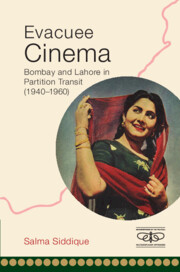Book contents
- Frontmatter
- Dedication
- Contents
- List of Figures
- Acknowledgements
- Introduction: A Moving Picture
- 1 The All-India Ambitions of Lahore
- Part 1 The Secular Stance of Bombay
- Part 2 Between Bombay and Pakistan
- Conclusion: Evacuee Cinema
- Appendix: Three Film Transcripts from the Fazli Family Collection
- Filmography
- Bibliography
- Index
3 - Stages of Partition: The Early Years of Prithvi Theatre
Published online by Cambridge University Press: 11 October 2022
- Frontmatter
- Dedication
- Contents
- List of Figures
- Acknowledgements
- Introduction: A Moving Picture
- 1 The All-India Ambitions of Lahore
- Part 1 The Secular Stance of Bombay
- Part 2 Between Bombay and Pakistan
- Conclusion: Evacuee Cinema
- Appendix: Three Film Transcripts from the Fazli Family Collection
- Filmography
- Bibliography
- Index
Summary
In the early 1950s, the Indian Motion Picture Producers’ Association (IMPPA) noted the difficulties in fully ‘exploiting’ Pakistani territories, which constituted nearly 20 per cent of the Hindustani–Urdu film market before partition. While the import duties and sales tax were commonly applicable to all Indian films, there was an additional handicap for movies starring Prithviraj Kapoor and his son Raj Kapoor. In April 1951, the Karachi Board of Film Censors had ‘informed the Sind and Baluchistan Film Distributors’ Syndicate that pictures in which Prithviraj and Raj Kapoor appear will not be passed in future’. This decision was based on a ‘certain amount of public resentment against Prithviraj’, and, accordingly, the films Barsaat (Rain, 1949) and Dahej (Dowry, 1950) were banned in Pakistan for some time. What were the reasons behind the Government of Pakistan's disfavour of Prithviraj? The answer may lie, as we will see, not in these films but in performances ancillary to film-making that initiated a rather public disaffection between Prithviraj Kapoor and the proponents of Pakistan.
The Indian films of the post-partition period continued to avoid sensitive contemporary themes partly out of censorship concerns and partly for commercial reasons. Ravi Vasudevan suggests that ‘the dearth of films directly confronting this event indicates that the film industry trod warily around the subject for fear of sectarian controversy’. Ira Bhaskar reasons that the immediacy and performative power of cinema made it a potentially dangerous medium for the communication of violence and displacement. ‘Partition violence or a depiction of inter-community Hindu Muslim relations … did not figure in Indian cinema for four decades’, as such representation had the potential of reopening old wounds.5 Bhaskar Sarkar locates a ‘resonant silence’ around partition in films and argues that what the films were unable to directly depict registered in implicit ways. And yet to a large extent this vacuum was filled in by theatre. Prithvi Theatre, a group closely associated with the Bombay chapter of the Indian People's Theatre Association (IPTA) as well as with the Bombay film industry, played partition right through the mid-1940s into the 1950s. While Prithvi Theatre has received attention in the recent decade or so, it awaits an appraisal of the thematic pivot of partition in the troupe's early performances.
- Type
- Chapter
- Information
- Evacuee CinemaBombay and Lahore in Partition Transit, 1940–1960, pp. 80 - 106Publisher: Cambridge University PressPrint publication year: 2023



